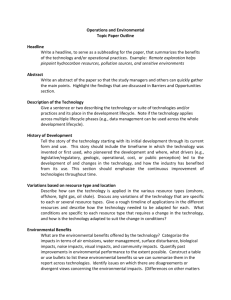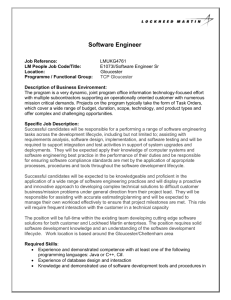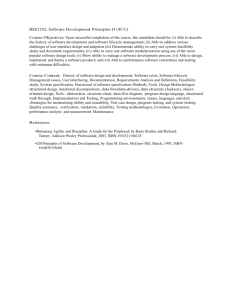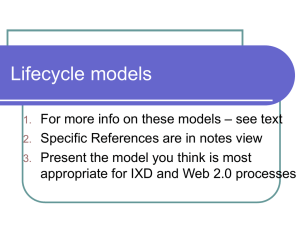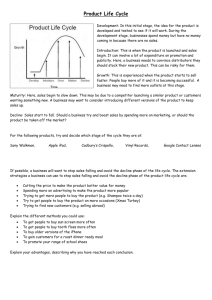Text Only
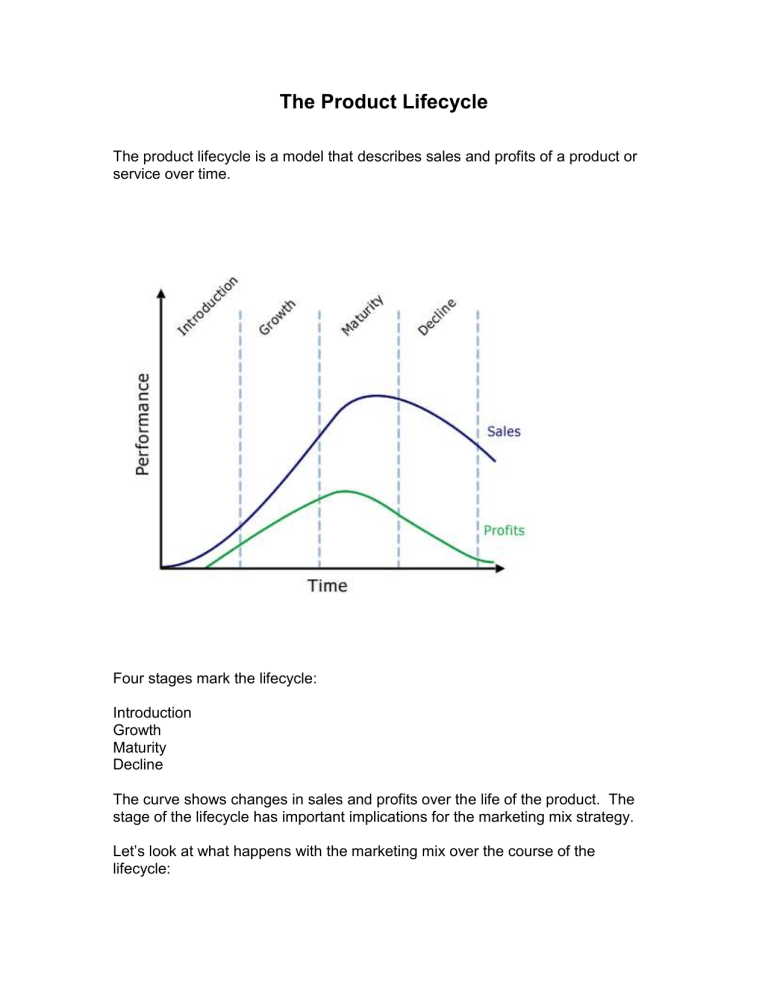
The Product Lifecycle
The product lifecycle is a model that describes sales and profits of a product or service over time.
Four stages mark the lifecycle:
Introduction
Growth
Maturity
Decline
The curve shows changes in sales and profits over the life of the product. The stage of the lifecycle has important implications for the marketing mix strategy.
Let’s look at what happens with the marketing mix over the course of the lifecycle:
As you can see, in the INTRODUCTORY stage , both sales and profits are low.
The overall marketing effort should be directed at stimulating demand for the product.
Product
Prior and during the launch process, R&D investments for the new product are high. Additionally the cost to produce the product is high as volume sold is limited.
Product strategies at this stage are focused on providing an offering that closely matches customer needs and wants.
Distribution
The risk associated with a new product innovation is quite high, consequently distribution tends to be limited. Limited distribution impacts the volume of product produced.
Promotion
Promotional efforts at this stage are aimed at building awareness of the product category itself. With no competition stirring up awareness for the product, all these promotional costs are borne entirely by the firm launching the product.
Price
Development of the pricing strategy during introduction is very difficult. The value of the product needs to be assessed while bearing in mind the increased cost of launching the product. Often to offset R&D costs and to take advantage of the first to market position, a price skimming strategy is used. Alternatively, firms may provide a temporary inducement, in the form of rebates or temporary price reductions, to build awareness.
Introductory Phase Example: Commercial Space Travel
Recall the characteristics that mark a product or service in the introductory stage of the lifecycle (i.e., minimal offerings, high price, educational advertising, limited distribution). The most recent
Neiman Marcus ® Christmas catalog offers a flight into space. The charter flight retails for $1,764,000.00. At this point, competition for this type of service is narrow at best.
In the GROWTH stage , both revenues and profits increase as awareness of the product grows, and competition enters the market. At the end of this growth stage however, you can see profits beginning to level off or decline.
The growth stage is marked by the entry of competition. Competition has the effect of increasing overall awareness of the product category. Competition also brings about the need to make products distinguishable from one another as consumers compare the value proposition of all offerings.
Unit cost to produce the product will likely decrease, due to scale economies and experience, as sales volume, and hence production volume increases. If product volumes remain low, product margins will begin to narrow more quickly.
At the same time, depending on the firm’s marketing strategy, the number of product offerings grows dramatically as products are customized to meet the needs of different market segments.
Consider that with increased competition, there is increased pressure on price .
This will impact profit margins unless costs for producing the product decline.
At the same time, promotional spending increases dramatically, first to increase product awareness and then to differentiate products from competing products.
Distribution is increased during this period both to stimulate demand (with new geographic markets, or segments) and to respond to growing demand. With this expansion come decisions regarding the nature of the distribution channel (the length and the breadth) and a growing investment in managing the channel.
So in the Growth stage, the expenses associated with the product have increased, but price is not likely to increase. With profits narrowing, by the end of the growth stage, some companies will begin to drop out of the market.
Growth Phase Example: High Definition Television
Digital Television is definitely in the growth stage. Consider the number of offerings in the High-definition television (HDTV) product category, and the resulting impact this variety has on price. Advertising for HDTV is still somewhat educational, but also demonstrates the efforts of manufacturers to distinguish their product from other products. What does it suggest about the level of competition for digital TVs? What do you suppose this technological advancement will do to the black and white TV?
By the Maturity stage the market for the product is flat. Many firms with low marketshare will exit the market. For those firms that stay in the market, the strategy is focused on maintaining marketshare. Because the product is not expanding, investments in the product are stable, and with high marketshare, the firms that stay alive experience stable profitability.
The product line is no longer expanding at this point. If no effort is made to revitalize the product, it will end up in decline. Breakthroughs in packaging or components are important to keep the product alive.
Distribution of the product has peaked but is still intensive.
Promotional efforts remain high to maintain marketshare, but begin to taper off as the product reaches the decline stage.
As competition drops off, pricing is held stable for as long as possible and sales promotions are used to stimulate product use.
Maturity Phase Example: Video Cassette Recorders
The adoption of digital video devices for home movie viewing, etc. has certainly relegated the VCR to a different stage in the product lifecycle. Many, if not most,
“Video” rental stores now stock only DVD recordings of movies. Video players can still be found in electronics stores, but the number of offerings has dwindled dramatically. DVD players now cost less than a video player. Is this the beginning of the end for this product?
In Decline, the overall focus is to harvest any potential profit from the product.
Product sales drop off, distribution narrows, promotional efforts are minimal, and price is decreased.
The lifecycle model can be an important input for marketing strategy decisions and the tactical decisions involved in the product’s marketing mix. Indicators such as level of competition, intensity of distribution, and level of sales can all be important in determining what stage of the lifecycle the product is in. Knowing the stage can assist a firm in assessing demand, understanding the required investment in the product, and in managing their product portfolio.
Decline Phase Example: Radio
In decline, a product must be somehow renewed, or the product will eventually disappear from store shelves. Consider the radio. What technological advances in audio technology in general threaten the radio? What clues are present that suggest that the traditional radio is on its way out?

